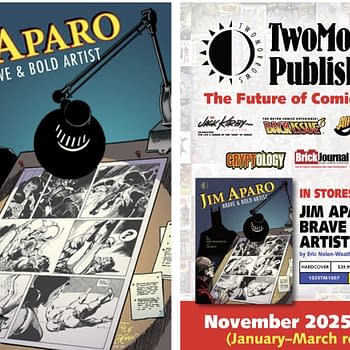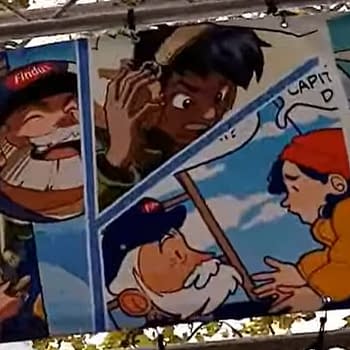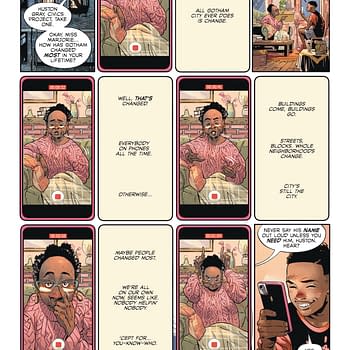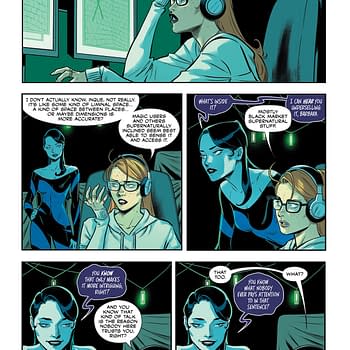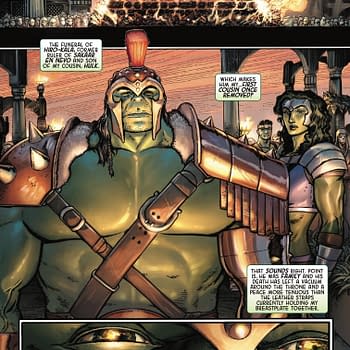Posted in: Comics | Tagged: comic con, Comics, eccc, muse, terry dodson
Terry Dodson Talks To Gavin Lees About His Muse
Gavin Lees is at ECCC for Bleeding Cool. He talks to Terry Dodson about his new graphic novel – Muse.

Why did you decide to create a comic for the French market?
I've just always been a fan of the European publishing. I really like that the art is given full consideration. It's not a slam, bang monthly comic book. You get a chance to really do a nice illustrated book. I grew up liking that stuff, so when the opportunity came, I was up for it. It's just nice to be able to be in charge of all the artwork yourself.
You say "the opportunity came up" — were you actively pursuing publishers over there?
No, they actually contact me because they were trying to get a foothold in the US with American artists they thought could cross over. So I was lucky that they picked because it was something that I wanted to do, but I wasn't sure how to approach a European publisher. So, fortunately, they approached me — which made it a lot easier.
Was this Les Humanoïdes Associés — as they were re-opening their American branch?
Yeah, right, but that was about 10 years ago now.
So, are you fluent in French? I would imagine the language could be a barrier to working in that area.
After my first trip when I went to go meet with them over there, I came back and I took French classes for a year and a half. You know — I was going to a foreign country and didn't want them having to spell things out for me all the time. Especially since French sounds so much different than how it's spelled. Aside from that I have Spanish, and a little bit of Italian, but French was a whole new thing. It was a fun challenge — being professional — taking the time to learn a little bit of the language so I could be professional. Plus it allowed me to read the books and get a better sense of the culture. It was a good challenge for my mind, to get away from drawing all the time, using my brain for figuring out something else aside from drawing problems. It definitely helped out.

Yeah, it's actually amazing that the very first time I went over there — before I started doing the Humanoids stuff — it was for a store signing and there was a huge crowd of comic book fans there. In the cities there are actually stores dedicated just to superhero stuff. But the cool thing is that the crossover is pretty broad, so it's very accepted for me to do one or the other and the fans would follow me, because they were used to seeing artists do a variety of stuff. The genre wasn't a problem — it was the main thing like it is here.
Are there any interesting artists that you've been exposed to while working in the French market, who maybe aren't as well known over here?
Yeah, there are tons, although they're all becoming famous over here now, because it's been a decade since I went over there. So, ten years ago, I was discovering these guys and a lot of them are still under-appreciated — the Blacksad artist, [Juanjo] Guarnido; Claire Wendling, although she's more of an animator, rather than a comics person, but still one of my favourites. Didier Cassegrain is one of my favourite artists right now — he also used to be animator, but he's starting to do comics stuff — he's one of my favourite guys.
You were working with a writer — Denis-Pierre Filippi — on this project. Did you get to choose who you worked with, or which project you worked on?
Humanoids offered me a number of projects and that happened to be one of the two that I really liked, and it was actually the one that would be the quickest to get on to. He had actually written the script already, so there wasn't a lot of input from me in terms of the story, but I liked it just as it was, so that wasn't a problem. With the second volume, though, we got to know each other and we were able to collaborate more on the second book. But again, I had been given the complete outline of the story, so I knew what I was getting into and I really thought it was cool and wanted to draw it.
Were there different expectations of you as an artist, in terms of what you needed to bring to the book?
I just knew that it was an opportunity to do all these things that I had been wanting to do. I pushed myself far more than the publishers did — there were very few pressures from them. It was my A game on every single page: every single colour, every single line was my A game… or even A+, going beyond what I had even done before, just because I was able to bring in all these influences I had from all this classic art and illustration, 19th century painting, advertising, all these elements that I just couldn't bring into superhero stuff. Beyond that, I did all the colours myself — I learned PhotoShop to do that and, since then, I've developed all the skills in order to colour all my covers here in the US. The last six years have seen me colour all my own covers, because of the skills I learned working on Coraline.

No. The first book was really loose. It took me less than three years to draw it, which is a long time, but I did that book while doing 30 issues of US work at the same time. When there were breaks in the US stuff, I worked on Coraline. Then, it took a while to colour it, because I was still learning.
When I took that job with Humanoids, I was working on the Kevin Smith Spider-Man/Black Cat book and I was fairly confident that there would be delays in the scripts…and, in the end, there turned out to be a three-year delay, so it really worked out well. It was a good decision on my part to forecast that. So, it was tough, but no-one really knew about it until it came out, so I had that advantage.
The second book I'm working on, there were a lot of delays before I was even brought onto it, and the company had a lot of financial problems, which caused even more delays. So, the second book — even though it's a long delay between volumes — I actually produced in about a third of the time. It's still difficult balancing that with my US work, so I think if I do another book like that, I'll do it full-time and get the book completed before moving back to Marvel or DC work.
What accounts for the lengthy delay in getting the book translated into English?
Instead of bringing out one book and then, a few years later, bringing out another book in English, they wanted the whole story in one big book. So, when the English version eventually comes out, it will be one complete story — beginning, middle, end — and that's it. Once you have that book, you don't need to wait around for the next one, which Humanoids felt the American audience would be more comfortable with — especially with a hardcover album, where they'll be getting over 100 pages, instead of only around 50.
Do you know when it's finally going to be released here, since Humanoids just recently pulled it from solicitation?
The problem has been production stuff. The book is all drawn, all coloured, but there were so many corrections that needed to be entered… it's almost done, but it's still not to the standard we want. It's only weeks away — in publishing terms, it's really just a blink of an eye away, but in real terms it's going to feel a lot longer. Then it's a matter of going to the printer and accounting for the printing time… but it'll definitely be this year.
Do you think this is the start of a long-term relationship with Humanoids now? Are you going to be a regular contributor to their line?
I don't know about necessarily Humanoids, but I definitely want to return to the European market. There are so many companies, so many creators to work with and I've had a lot of opportunities, met a lot of people, since this stuff has come out. It's a great marketplace to work in, so I will definitely be doing more European stuff in the future. It's so nice to have the chance to do that variety of work as opposed to what I can do here. I already know what I can do here in the US, and it's nice to challenge myself, and I think people are a lot more receptive to non-superhero material now, too…which is good for me.

Yeah, I do have some ideas for ideas for writing, but I keep getting scripts from people and they're great. People keep telling me, "Oh, this guy wants to work with you," and I'm like, "Oh, that's cool…" So, all my own plans keep getting put on the backburner, but at some point I'll probably write my own stuff, but I keep finding people to collaborate with or keep getting sent great ideas… which are better than my ideas. It's a good problem to have, I guess. Ideally, it'd be nice to do the whole thing myself, just beause I think pacing-wise, it would be closer to my vision of how a story works, and it would be my own creation. I really should be doing my own thing — anyone who's a great cartoonist does it all themselves. We'll see.
—
As for me, I hope I'll be screaming "Yes!" like Molly Bloom as the universe rolls up into a silver paper ball for the quantum cats of Hell to play with – Gavin.








